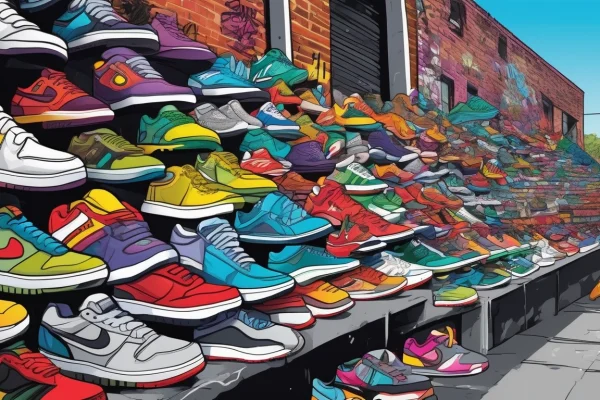Who Inspired the Evolution of Sneakers?

- Who Inspired the Evolution of Sneakers?
- Historical Origins of Sneakers
- Influential Athletes and Their Impact
- The Rise of Basketball Sneakers
- Signature Lines and Collaborations
- Cultural Significance of Sneakers
- The Role of Technology in Sneaker Design
- Fashion Trends and Sneakers
- High Fashion Meets Streetwear
- Environmental Considerations in Sneaker Production
- Frequently Asked Questions
When we think about sneakers, we often envision stylish designs and cutting-edge technology, but the journey of these iconic shoes is deeply rooted in cultural influences and historical significance. The evolution of sneakers is not just about their physical appearance; it’s about the stories behind them, the people who wore them, and the movements that propelled them into the spotlight. From humble beginnings to becoming a global phenomenon, sneakers have been shaped by various key figures and cultural movements.
In the early days, sneakers were primarily designed for functionality, serving the needs of athletes and casual wearers alike. The materials and designs were simple, but they laid the foundation for what was to come. As we moved through the decades, the sneaker culture began to take shape, driven by athletes who not only pushed the limits of their sports but also influenced fashion trends. Think of legends like Michael Jordan and Serena Williams, who didn’t just wear sneakers; they became synonymous with the brands they represented, creating a ripple effect in the sneaker industry.
Moreover, the intersection of sports and fashion has redefined how we perceive sneakers today. They are no longer just athletic gear; they have become a statement of identity. With the rise of sneaker culture, we see collaborations between high-end designers and streetwear brands, leading to unique creations that cater to fashion enthusiasts and collectors alike. This fusion of styles has transformed sneakers into a symbol of lifestyle, reflecting societal values and trends.
As we delve deeper into the evolution of sneakers, it’s essential to recognize the impact of technology. Innovations in materials and design have not only enhanced performance but also made sneakers more accessible and appealing to a broader audience. This ongoing transformation continues to inspire new generations, ensuring that sneakers remain an integral part of both athletic and fashion landscapes.

Historical Origins of Sneakers
Understanding the beginnings of sneakers is like peeling back the layers of an onion, revealing a rich history that intertwines innovation, culture, and style. The term “sneaker” itself originated in the late 19th century, derived from the rubber sole that allowed wearers to move quietly, almost sneakily. Early designs were primarily for athletic purposes, with the first known pair being the Plimsoll, introduced in the 1830s in England. This simple shoe featured a canvas upper and rubber sole, paving the way for what we now recognize as modern sneakers.
As we moved into the 20th century, sneakers began to gain traction beyond the sports arena. The introduction of brands like Converse and Keds revolutionized the footwear landscape. The Converse All Star, launched in 1917, became a cultural icon, especially in the realms of basketball and, later, rock and roll. This shift marked a significant turning point, as sneakers transitioned from mere athletic gear to a fashion statement.
Moreover, the social context of the time played a crucial role in the sneaker’s evolution. The post-war era saw an explosion in leisure activities and youth culture, leading to a surge in casual footwear. By the 1980s, sneakers had firmly established themselves in popular culture, thanks in part to the rise of hip-hop and street fashion. This era saw the emergence of brands like Nike, which not only focused on performance but also tapped into the lifestyle market.
Today, sneakers are a global phenomenon, with a diverse range of styles catering to various tastes and preferences. From high-performance athletic shoes to designer collaborations, the evolution of sneakers reflects broader trends in society and culture. As we continue to explore the sneaker landscape, it’s fascinating to see how these humble beginnings have led to a multi-billion dollar industry that resonates with people from all walks of life.

Influential Athletes and Their Impact
When we think about sneakers, it’s impossible to ignore the massive influence athletes have had on their evolution. From the courts to the streets, these sports icons have not only transformed how we view athletic footwear but have also redefined style and cultural significance. The partnership between athletes and sneaker brands has created a dynamic market, where performance meets fashion, and this relationship continues to shape trends today.
Take Michael Jordan, for example. His signature line with Nike, the Air Jordan, didn’t just change basketball shoes; it revolutionized the sneaker industry. When the first Air Jordans hit the market in 1985, they were more than just shoes; they became a cultural phenomenon. Basketball fans and sneakerheads alike clamored for a piece of the action, and suddenly, sneakers were no longer just for athletes—they were a status symbol.
Other athletes like LeBron James and Kobe Bryant followed suit, launching their own lines that combined performance technology with personal flair. These collaborations have created a unique niche where individual branding and athletic excellence collide. The result? A generation of fans who not only want to support their favorite players but also aspire to emulate their style.
Moreover, the impact of athletes extends beyond the court. Sneakers have become embedded in popular culture, often seen in music videos, movies, and social media. This has led to a growing trend where sneakers are viewed as essential fashion items, blurring the lines between sports and lifestyle. The rise of sneaker culture has given birth to conventions and communities dedicated to celebrating these iconic shoes.
In conclusion, the relationship between influential athletes and sneaker design is a powerful one. These icons have not only shaped the way we perceive sneakers but have also created a lasting legacy that continues to inspire both athletes and fashion enthusiasts alike. As we look to the future, it’s clear that the impact of these sports legends will only grow stronger, driving innovation and style in the sneaker world.
The Rise of Basketball Sneakers
The evolution of basketball sneakers is nothing short of a cultural phenomenon. It all began in the 1980s when basketball players started to make their mark not just on the court but also in the realm of fashion. Michael Jordan, perhaps the most iconic figure in this narrative, transformed the sneaker landscape with his signature line, the Air Jordan. This wasn’t just a shoe; it was a game-changer. The fusion of performance and style made these sneakers a must-have, not only for athletes but for anyone wanting to make a statement.
Basketball sneakers became synonymous with innovation and personal branding. Brands recognized the potential of partnering with athletes to create signature lines that resonated with fans. For instance, the collaboration between Nike and Jordan opened the floodgates for a slew of athlete-endorsed sneakers. Today, we see a plethora of basketball shoes that cater to various styles and preferences. Some of the most notable include:
- Nike Air Jordan – A pioneer in the sneaker revolution.
- Adidas Yeezy – Blending performance with streetwear aesthetics.
- Puma Clyde – A classic that remains relevant.
The impact of these sneakers extends beyond the court, influencing streetwear and fashion trends globally. Wearing basketball sneakers has become a form of self-expression, allowing individuals to showcase their personal style while paying homage to their favorite players. The hype surrounding limited releases and collaborations has created a subculture within sneaker culture, where fans eagerly anticipate drops and engage in trading and collecting.
In conclusion, the rise of basketball sneakers is a testament to how sports can transcend their original purpose. They have become cultural icons, reflecting the intersection of athletics, fashion, and identity. As we look to the future, one can only imagine how this dynamic relationship will continue to evolve, pushing the boundaries of what sneakers can represent.
Signature Lines and Collaborations
When it comes to sneakers, signature lines and collaborations have become the heartbeat of the industry. These unique partnerships between athletes and brands not only redefine performance but also create a personal touch that resonates with fans. Think of it this way: just as a musician’s signature sound defines their career, an athlete’s signature sneaker can shape their legacy.
Take Michael Jordan, for instance. His Air Jordan line revolutionized the sneaker game, blending top-notch performance with street style. It’s not just about the shoes; it’s about the story behind them. Each model tells a tale of triumph, struggle, and cultural significance. Today, the Air Jordan brand stands as a symbol of excellence, inspiring countless athletes and sneakerheads alike.
But Michael isn’t alone in this sneaker revolution. Other athletes like LeBron James, Kobe Bryant, and Serena Williams have launched their own lines, each bringing something fresh and unique to the table. These collaborations often include:
- Innovative Designs: Each athlete’s personality shines through in their sneaker designs, from bold colors to unique patterns.
- Performance Enhancements: Collaborations often lead to cutting-edge technology that improves comfort and functionality.
- Cultural Impact: Many signature lines transcend sports, becoming fashion statements that reflect broader cultural movements.
Moreover, brands like Nike and Adidas have recognized the power of collaboration, teaming up with fashion designers and artists to create limited-edition releases. These partnerships blur the lines between high fashion and athletic wear, making sneakers a must-have item in any wardrobe. The result? A vibrant sneaker culture that celebrates creativity and individuality.
In essence, signature lines and collaborations are more than just marketing strategies; they are a celebration of identity and expression. As we continue to witness the evolution of sneakers, one thing is clear: these unique partnerships will remain at the forefront, shaping the future of footwear in ways we can only imagine.
Cultural Significance of Sneakers
Sneakers have grown to symbolize much more than mere athletic footwear; they represent cultural identity, social movements, and a unique blend of fashion and functionality. From the streets of New York to the runways of Paris, sneakers have woven themselves into the very fabric of modern culture. Have you ever wondered why a simple pair of shoes can evoke such strong emotions and connections? It’s all about the stories they tell and the communities they foster.
Throughout history, sneakers have been at the forefront of various cultural movements. In the 1980s, hip-hop artists donned their favorite kicks, turning them into a symbol of rebellion and self-expression. The vibrant colors and bold designs became a canvas for creativity, allowing individuals to showcase their personalities. This trend didn’t just stop in the United States; it spread globally, influencing fashion and music scenes across continents.
Moreover, sneakers have become a status symbol in many societies. Limited edition releases and collaborations with renowned designers or celebrities often create a frenzy among sneaker enthusiasts. The excitement surrounding these releases can be compared to the thrill of a concert ticket drop—everyone wants to be part of the exclusive club. For instance, brands like Nike and Adidas have successfully tapped into this phenomenon, launching signature lines that resonate with fans and collectors alike.
In addition to their role in fashion and music, sneakers have also been associated with social justice movements. For example, during protests, wearing specific sneakers can signify solidarity and support for a cause. This connection between footwear and activism highlights how deeply intertwined sneakers are with societal values and issues.
Ultimately, the cultural significance of sneakers lies in their ability to adapt and evolve. They are not just shoes; they are a reflection of our times, our values, and our aspirations. As we continue to embrace diversity and change, sneakers will undoubtedly remain a powerful symbol of cultural expression.
The Role of Technology in Sneaker Design
When it comes to sneakers, technology is the unsung hero that has propelled the design and functionality of footwear into a new era. Imagine lacing up a pair of shoes that not only look great but also enhance your performance on the court or during your daily jog. This is the magic of modern sneaker technology, where innovation meets style!
From the introduction of air cushioning systems to the latest in 3D printing, sneaker design has undergone a remarkable transformation. Brands have invested heavily in research and development to create shoes that offer maximum comfort and support. For instance, Nike’s Air Max technology revolutionized the way we think about cushioning, providing a lightweight feel without sacrificing impact protection. But that’s just the tip of the iceberg!
Today’s sneaker designs often incorporate:
- Advanced Materials: Breathable fabrics and lightweight synthetics ensure that sneakers adapt to the wearer’s foot, providing a snug fit that enhances performance.
- Smart Technology: Some sneakers now come equipped with sensors that track performance metrics like speed and distance, merging the worlds of fitness and technology.
- Sustainable Practices: With a growing emphasis on environmental responsibility, brands are utilizing recycled materials and eco-friendly production methods, showcasing how tech can help save the planet.
Moreover, the integration of technology in sneaker design isn’t just about performance; it’s also about aesthetics. Designers are using cutting-edge techniques to create visually stunning shoes that stand out in a crowd. The collaboration between tech and fashion has given rise to unique patterns and colorways that appeal to sneaker enthusiasts and fashionistas alike.
In summary, the role of technology in sneaker design is multifaceted, blending functionality with fashion. As we look to the future, it’s exciting to think about how emerging technologies will continue to shape the sneaker landscape, making our favorite footwear even more innovative and stylish!

Fashion Trends and Sneakers
Sneakers have transcended their original purpose of athletic performance to become a fashion staple that reflects personal style and cultural identity. Over the decades, we’ve witnessed a remarkable evolution in sneaker designs, with styles that cater to both function and fashion. From classic silhouettes to avant-garde creations, the sneaker landscape is as diverse as the people who wear them. Have you ever noticed how a simple pair of sneakers can elevate an entire outfit? That’s the magic of fashion and sneakers working hand in hand.
In the 1980s, sneakers started to gain traction in the fashion world, largely thanks to the rise of hip-hop culture and influential figures who rocked them on and off the stage. Fast forward to today, and sneakers are not just for athletes anymore; they’ve become a canvas for creativity. Designers collaborate with sneaker brands to create limited-edition releases that often sell out within minutes. These collaborations have become highly sought after, making sneakers a valuable addition to any wardrobe.
Moreover, the rise of streetwear has significantly influenced sneaker trends. Brands like Supreme and Off-White have blurred the lines between high fashion and casual wear, leading to a new era where sneakers are seen as luxury items. The intersection of high fashion and streetwear is where you’ll find some of the most exciting sneaker designs today. For instance, the collaboration between Nike and designer Virgil Abloh has taken the sneaker world by storm, making it clear that sneakers are now a part of the luxury fashion conversation.
As we look to the future, it’s important to consider how sustainability is shaping sneaker fashion trends. More brands are prioritizing eco-friendly materials and ethical production practices, which not only appeal to environmentally conscious consumers but also set new standards for the industry. In this way, sneakers are not just a fashion statement; they are also a statement of values.
In conclusion, sneakers have evolved into a multifaceted fashion phenomenon, reflecting broader trends in society. Whether you’re a sneakerhead or just someone who appreciates a good pair of kicks, it’s clear that sneakers will continue to play a significant role in the world of fashion.
High Fashion Meets Streetwear
In recent years, the fusion of high fashion and streetwear has completely transformed the sneaker landscape. This unexpected marriage has created a buzz that resonates not just with fashion aficionados but also with everyday sneaker lovers. Imagine walking down the street and spotting someone rocking a pair of designer sneakers that scream luxury while still holding onto that casual vibe. It’s a game-changer!
One of the most fascinating aspects of this trend is how it challenges traditional fashion norms. High fashion brands are now collaborating with streetwear icons, resulting in limited-edition releases that fly off the shelves. For instance, collaborations between brands like Balenciaga and Adidas, or Off-White and Nike, have not only elevated sneaker culture but also blurred the lines between what is considered high-end and what is considered casual.
These collaborations often feature unique designs, bold colors, and innovative materials that attract a diverse audience. They are not just shoes; they are statements! Each pair tells a story of creativity and cultural significance. The sneaker community eagerly anticipates these drops, often leading to frenzied lines and online sell-outs that showcase the demand for these unique pieces.
Moreover, this trend reflects a broader shift in consumer behavior. Today’s shoppers are looking for versatility in their wardrobes. Sneakers that can transition from the runway to the street are in high demand. This has led to a new era where comfort meets style, allowing people to express their individuality without sacrificing ease.
As we look to the future, it’s clear that the intersection of high fashion and streetwear will continue to evolve. Who knows what the next big collaboration will be? One thing is for sure: sneakers will remain at the forefront of this exciting fashion evolution, captivating hearts and feet alike!
Environmental Considerations in Sneaker Production
In today’s world, where sustainability is more than just a buzzword, sneaker production is undergoing a significant transformation. Brands are recognizing the importance of reducing their environmental footprint, and this shift is inspiring a new generation of eco-conscious consumers. But what does this mean for the sneaker industry? Well, it involves a careful examination of materials, manufacturing processes, and the overall lifecycle of the product.
Many companies are now opting for recycled materials in their sneakers, which not only helps in conserving resources but also reduces waste. For instance, some brands use recycled plastics and rubber to create stylish and functional footwear. This innovation not only appeals to environmentally minded consumers but also sets a trend for others to follow. Just imagine wearing a pair of sneakers that helped keep plastic out of our oceans!
Moreover, the production process itself is being scrutinized. Ethical manufacturing practices are becoming a priority, ensuring that workers are treated fairly and that the production methods are safe and sustainable. This is crucial, as consumers are increasingly aware of the social implications of their purchases. Brands that prioritize ethical practices often find themselves earning the loyalty of a growing customer base.
Another fascinating aspect is the rise of biodegradable sneakers. Yes, you heard that right! Some innovative companies are developing shoes that can decompose naturally after their lifespan, significantly reducing landfill waste. This is a game-changer in an industry that has long been associated with disposable fashion.
To summarize, the sneaker industry is at a crossroads. As brands embrace environmental considerations, they are not only paving the way for a more sustainable future but also appealing to a market that values responsibility. The changes being made today could set the standard for tomorrow’s footwear, making it possible for us to step forward in style without stepping on the planet.
Frequently Asked Questions
- What are the historical origins of sneakers?
Sneakers originated in the late 18th century, initially designed for sports and outdoor activities. The use of rubber soles and canvas uppers made them more comfortable and flexible compared to traditional leather shoes.
- How have athletes influenced sneaker designs?
Athletes have been instrumental in shaping sneaker culture through endorsements and signature lines. Icons like Michael Jordan not only improved performance with their designs but also made sneakers a fashion statement.
- What role does technology play in sneaker design?
Technological advancements have revolutionized sneaker design, introducing innovative materials and features that enhance comfort, durability, and performance. Brands are constantly experimenting with new technologies to meet the needs of both athletes and casual wearers.
- How do sneakers reflect cultural trends?
Sneakers have evolved beyond their athletic roots to become symbols of cultural identity and street fashion. They reflect societal trends, movements, and the blending of different fashion styles, making them a staple in modern wardrobes.
- What is the significance of sustainability in sneaker production?
As environmental awareness grows, many sneaker brands are prioritizing eco-friendly materials and ethical production practices. This shift not only appeals to conscious consumers but also contributes to a more sustainable future for the fashion industry.





